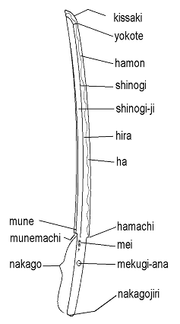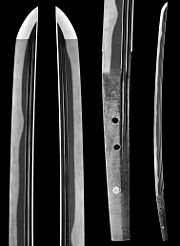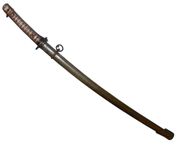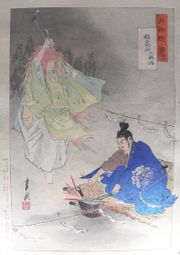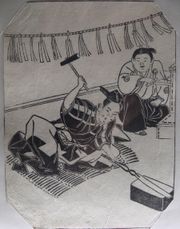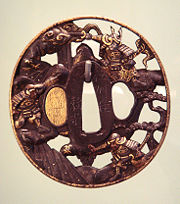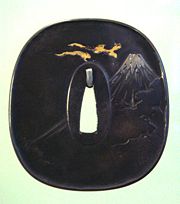Japanese sword
2008/9 Schools Wikipedia Selection. Related subjects: Military History and War
A Japanese sword, or nihontō (日本刀 or にほんとう lit. Japanese sword ?), is one of the traditional bladed weapons of Japan. These are categorised in several types according to size and method of manufacture. The most commonly known type is the katana, which, like the similarly formed tachi, is a single-edged and, usually, curved long sword which was traditionally used by samurai from the 1400s onwards; Wakizashi is the shorter sword; Tsurugi are double-edged long swords; Ōtachi or Nodachi are older but longer single-edged versions.
Although they are pole-mounted weapons the Naginata and Yari, due to the methods by which they are forged, are still considered part of the Nihonto family.
Japanese swords are still commonly seen; antique and modernly-forged swords can easily be found and purchased. Modern, authentic nihontō are made by a few hundred swordsmiths. Many examples can be seen at contests hosted by the All-Japan Swordsmiths Association.
Naming
The word katana was used in ancient Japan and is still used today, whereas the word nihontō originated in China, in the poem 日本刀歌, the Song of Nihonto by the Song Dynasty poet Ouyang Xiu. The word nihonto became more common in Japan in the late Tokugawa shogunate. Due to importation of Western swords and culture, the word nihonto (literally "the sword of Japan") was adopted as an act of nationalism.
History of the Japanese sword
Early history
Before 987, examples of Japanese swords were straight chokutō or jōkotō and others with unusual shapes. In the Heian period (8th to 11th centuries) sword-making developed through techniques brought over from China through trade in the early 10th century during the Tang Dynasty and through Siberia and Hokkaidō, territory of the Ainu people. The Ainu used warabite-tō (蕨手刀 ?) and these influenced the nihontō, which was held with two hands and designed for cutting, rather than stabbing. According to legend, the Japanese sword was invented by a smith named Amakuni (ca.700 AD), along with the folded steel process. In reality the folded steel process and single edge swords had been brought over from China through trade in the early 10th century during the Tang Dynasty. Swords forged between 987 and 1597 are called kotō (古刀 ?) (lit., "old swords"); these are considered the pinnacle of Japanese swordcraft. Early models had uneven curves with the deepest part of the curve at the hilt. As eras changed the centre of the curve tended to move up the blade.
The nihonto as we know it today with its deep, graceful curve has its origin in shinogi-zukuri (single-edged blade with ridgeline) tachi which were developed sometime around the middle of the Heian period to service the need of the growing military class. Its shape reflects the changing form of warfare in Japan. Cavalry were now the predominant fighting unit and the older straight chokutō were particularly unsuitable for fighting from horseback. The curved sword is a far more efficient weapon when wielded by a warrior on horseback where the curve of the blade adds considerably to the downward force of a cutting action.
The tachi is a sword which is generally larger than a katana, and is worn suspended with the cutting edge down. This was the standard form of carrying the sword for centuries, and would eventually be displaced by the katana style where the blade was worn thrust through the belt, edge up. The tachi was worn slung across the left hip. The signature on the tang (nakago) of the blade was inscribed in such a way that it would always be on the outside of the sword when worn. This characteristic is important in recognising the development, function and different styles of wearing swords from this time onwards.
When worn with full armour, the tachi would be accompanied by a shorter blade in the form known as koshigatana ("waist sword"); a type of short sword with no hand-guard (tsuba) and where the hilt and scabbard meet to form the style of mounting called an aikuchi ("meeting mouth"). Daggers (tantō), were also carried for close combat fighting as well as carried generally for personal protection.
The Mongol invasions of Japan in the thirteenth century spurred further evolution of the Japanese sword. Often forced to abandon traditional mounted archery for hand-to-hand combat, many samurai found that their swords were too delicate and prone to damage when used against the thick leather armor of the invaders. In response, Japanese swordsmiths started to adopt thinner and simpler temper lines. Certain Japanese swordsmiths of this period began to make blades with thicker backs and bigger points as a response to the Mongol threat.
By the fifteenth century, the Sengoku Jidai civil war erupted, and the vast need for swords together with the ferocity of the fighting caused the highly artistic techniques of the Kamakura period (known as the "Golden Age of Swordmaking") to be abandoned in favour of more utilitarian and disposable weapons. The export of nihontō reached its height during the Muromachi period when at least 200,000 nihontō were shipped to Ming Dynasty China in official trade in an attempt to soak up the production of Japanese weapons and make it harder for pirates in the area to arm.
In the 15th and 16th centuries, samurai who increasingly found a need for a sword for use in closer quarters along with increasing use of foot-soldiers armed with spears lead to the creation of the uchigatana, in both one-handed and two-handed forms. As the Sengoku civil wars progressed, the uchigatana evolved into the modern katana, and replaced the tachi as the primary weapon of the samurai, especially when not wearing armor. Many longer tachi were shortened in the 15th-17th centuries to meet the demand for katana.
The craft decayed as time progressed and firearms were introduced as a decisive force on the battlefield. At the end of the Muromachi era, the Tokugawa shoguns issued regulations controlling who could own and carry swords, and effectively standardized the description of a nihontō.
New swords
In times of peace, swordsmiths returned to the making of refined and artistic blades, and the beginning of the Momoyama period saw the return of high quality creations. As the techniques of the ancient smiths had been lost during the previous period of war, these swords were called shintō (新刀 ?), literally "new swords". Generally they are considered inferior to most kotō ("old swords"), and coincide with a decline in manufacturing skills. As the Edo period progressed, blade quality declined, though ornamentation was refined. Originally, simple and tasteful engravings known as horimono were added for religious reasons. Later, in the more complex work found on many shintō, form no longer strictly followed function.
Under the isolationist Tokugawa shogunate, swordmaking and the use of firearms declined. The master swordsmith Suishinshi Masahide (c.1750–1825); published opinions that the arts and techniques of the shintō swords were inferior to the kotō blades, and that research should be made by all swordsmiths to rediscover the lost techniques. Masahide traveled the land teaching what he knew to all who would listen, and swordsmiths rallied to his cause and ushered in a second renaissance in Japanese sword smithing. With the discarding of the shintō style, and the re-introduction of old and rediscovered techniques, swords made in the kotō style between 1761 and 1876 are shinshintō (新新刀 ?), "new revival swords" or literally "new-new swords." These are considered superior to most shintō, but inferior to true kotō.
The arrival of Matthew Perry in 1853 and the subsequent Convention of Kanagawa forcibly reintroduced Japan to the outside world; the rapid modernization of the Meiji Restoration soon followed. The Haitorei edict in 1876 all but banned carrying swords and guns on streets. Overnight, the market for swords died, many swordsmiths were left without a trade to pursue, and valuable skills were lost. The nihontō remained in use in some occupations such as the police force. At the same time, kendo was incorporated into police training so that police officers would have at least the training necessary to properly use one.
In time, it was rediscovered that soldiers needed to be armed with swords, and over the decades at the beginning of the 20th century swordsmiths again found work. These swords, derisively called guntō, were often oil-tempered, or simply stamped out of steel and given a serial number rather than a chiseled signature. The mass-produced ones often look like Western cavalry sabers rather than nihontō, with blades slightly shorter than blades of the shintō and shinshintō periods.
Military swords hand made in the traditional way are often termed as gendaitō. The craft of making swords was kept alive through the efforts of a few individuals, notably Gassan Sadakazu (月山貞一, 1836–1918) and Gassan Sadakatsu (月山貞勝, 1869–1943), who were employed as Imperial artisans. These smiths produced fine works that stand with the best of the older blades for the Emperor and other high ranking officials. The students of Sadakatsu went on to be designated Intangible Cultural Assets, "Living National Treasures," as they embodied knowledge that was considered to be fundamentally important to the Japanese identity. In 1934 the Japanese government issued a military specification for the shin guntō (new army sword), the first version of which was the Type 94 Katana, and many machine- and hand-crafted swords used in World War II conformed to this and later shin guntō specifications.
Recent history and modern use
Under the United States occupation at the end of World War II all armed forces in occupied Japan were disbanded and production of nihontō with edges were banned except under police or government permit. The ban was overturned through a personal appeal by Dr. Junji Honma. During a meeting with General Douglas MacArthur, Dr. Honma produced blades from the various periods of Japanese history and MacArthur was able to identify very quickly what blades held artistic merit and which could be considered purely weapons. As a result of this meeting, the ban was amended so that guntō weapons would be destroyed while swords of artistic merit could be owned and preserved. Even so, many nihontō were sold to American soldiers at a bargain price; in 1958 there were more Japanese swords in America than in Japan. The vast majority of these one million or more swords were guntō, but there was still a sizable number of older swords.
After the Edo period, swordsmiths turned increasingly to the production of civilian goods. The Occupation and its regulations almost put an end to the production of nihonto. A few smiths continued their trade, and Dr. Honma went on to be a founder of the Society for the Preservation of the Japanese Sword (日本美術刀剣保存協会 Nippon Bijutsu Tōken Hozon Kyōkai ?), who made it their mission to preserve the old techniques and blades. Thanks to the efforts of other like-minded individuals, the nihontō did not disappear, many swordsmiths continued the work begun by Masahide, and the old swordmaking techniques were rediscovered.
Modern nihonto manufactured according to traditional methods are usually known as shinsakutō (新作刀 ?), meaning "newly made swords". Alternately, they can be termed shinken (真剣 ?) when they are designed for combat as opposed to iaitō training swords.
Due to their popularity in modern media, display-only "nihontō" have become widespread in the sword marketplace. Ranging from small letter openers to scale replica "wallhangers", these items are commonly made from stainless steel (which makes them either brittle or poor at holding an edge) and have either a blunt or very crude edge. There are accounts of good quality stainless steel nihontō, however, these are rare at best. Some replica nihontō have been used in modern-day armed robberies, which became the reason for a possible ban on sale, import and hire of samurai swords in the UK. As a part of marketing, modern a-historic blade styles and material properties are often stated as traditional and genuine, promulgating disinformation.
In Japan, genuine edged hand-made Japanese swords, whether antique or modern, are classified as art objects (and not weapons) and must have accompanying certification in order to be legally owned. It should be noted that some companies and independent smiths outside of Japan produce katana as well, with varying levels of quality.
Classification of Japanese swords
What generally differentiates the different swords is their length. Japanese swords are measured in units of shaku (one shaku is approximately equivalent to 30 cm or one foot). A blade shorter than one shaku is considered a tantō (knife). A blade longer than one shaku but less than two is considered a shōtō (short sword). The wakizashi and kodachi are in this category.
A blade longer than two shaku is considered a daitō, or long sword. Before 1500 most swords were usually worn suspended from cords on a belt, edge-down. This style is called jindachi-zukuri, and daitō worn in this fashion are called tachi (average blade length of 75-80 cm). From 1600 to 1867, more swords were worn through an obi (sash), paired with a smaller blade; both worn edge-up. This style is called buke-zukuri, and all daitō worn in this fashion are katana, averaging 70-74 cm (2 shaku 3 sun to 2 shaku 4 sun 5 bu) in blade length. However, nihontō of longer lengths also existed, including lengths up to 78 cm (2 shaku 5 sun 5 bu). The weight of a nihontō rarely exceed 1 kg without the saya.
A chisakatana is simply a shorter nihontō. It is longer than the wakizashi, lying between one and two shaku in length. The most common reference to a chiisakatana is a shorter nihontō that does not have a companion blade. They were most commonly made in the buke-zukuri mounting.
Abnormally long blades (longer than 3 shaku), usually carried across the back, are called ōdachi or nodachi. The word ōdachi is also sometimes used as a synonym for nihontō. The odachi translated means "Great Sword" and Nodachi translates to "Field sword". Nodachi were used during war as the longer sword gave a foot soldier a reach advantage, but now the nodachi are illegal because of its effectiveness as a killing weapon. Citizens are not allowed to possess an odachi unless it is for ceremonial purposes.
Here is a list of lengths for different types of swords:
- Nodachi, Ōdachi, Jin tachi: 90cm and over.
- Tachi: 80 to 90 cm
- Katana: 71 to 76 cm
- Chisakatana: 60 to 66 cm
- Wakizashi: 55 to 58 cm
- Tantō, Aikuchi: 28 to 41 cm
- Yoroi toshi: 23 to 30 cm
- Kwaiken: 8 to 15 cm
Since 1867, restrictions and/or the deconstruction of the samurai class meant that most blades have been worn jindachi-zukuri style, like Western navy officers. Recently (since 1953) there has been a resurgence in the buke-zukuri style, permitted only for demonstration purposes. Swords designed specifically to be tachi are generally kotō rather than shintō, so they are generally better manufactured and more elaborately decorated. However, these are still katana if worn in modern buke-zukuri style.
Most old Japanese swords can be traced back to one of five provinces, each of which had its own school, traditions and "trademarks" (e.g., the swords from Mino province were "from the start famous for their sharpness"). These schools are known as Gokaden (The Five Traditions). These traditions and provinces are as follows:
- Sōshū School, known for itame hada and midareba hamon in nie deki.
- Yamato School, known for masame hada and suguha hamon in nie deki.
- Bizen School, known for mokume hada and midareba hamon in nioi deki.
- Yamashiro School, known for mokume hada and suguha hamon in nei deki.
- Mino School, known for hard mokume hada and midareba mixed with togari-ba.
In the Kotō era there were several other schools that did not fit within the Gokaden or were known to mix elements of each Gokaden, and they were called wakimono (small school). There were 19 commonly referenced wakimono.
Manufacturing
Nihontō and wakizashi were often forged with different profiles, different blade thicknesses, and varying amounts of grind. Wakizashi were not simply scaled-down nihontō; they were often forged in hira-zukuri or other such forms which were very rare on nihontō.
The daishō was not always forged together. If a samurai was able to afford a daishō, it was often composed of whichever two swords could be conveniently acquired, sometimes by different smiths and in different styles. Even when a daishō contained a pair of blades by the same smith, they were not always forged as a pair or mounted as one. Daishō made as a pair, mounted as a pair, and owned/worn as a pair, are therefore uncommon and considered highly valuable, especially if they still retain their original mountings (as opposed to later mountings, even if the later mounts are made as a pair).
Forging
The forging of a Japanese blade typically took hours, days, or even weeks and was considered a sacred art. As with many complex endeavors, rather than a single craftsman, several artists were involved. There was a smith to forge the rough shape, often a second smith (apprentice) to fold the metal, a specialist polisher (called a togi) as well as the various artisans that made the koshirae (the various fittings used to decorate the finished blade and saya (sheath) including the tsuka (hilt), fuchi (collar), kashira (pommel), and tsuba (hand guard)).
The Japanese sword blade is formed from a combination of two different steels: a harder outer jacket steel wrapped around a relatively softer, inner core of steel. This creates a blade which has a unique hard, highly razor sharp cutting edge with an inner core which is resilient and able to absorb shocks in a way which reduces the possibility of the blade breaking or bending when used in combat. The hadagane, for the outer skin of the blade, is produced by heating a block of high quality raw steel, which is then hammered out into a bar, and the flexible back portion. This is then cooled and broken up into smaller blocks which are checked for further impurities and then reassembled and reforged. During this process the billet of steel is heated and hammered, split and folded back upon itself many times and re-welded to create a complex structure of many thousands of layers. Each different steel is folded a differing number of times to provide the necessary strength and flexibility to the different steels. The precise way in which the steel is folded, hammered and re-welded determines the distinctive grain pattern of the blade, the jihada, (also called jigane when referring to the actual surface of the steel blade) a feature which is indicative of the period, place of manufacture and actual maker of the blade.
The shingane (for the inner core of the blade) is of a relatively softer steel with a lower carbon content than the hadagane. For this, the block is again hammered, folded and welded in a similar fashion to the hadagane, but with fewer folds. At this point, the hadagane block is once again heated, hammered out and folded into a ‘U’ shape, into which the shingane is inserted to a point just short of the tip. The new composite steel billet is then heated and hammered out ensuring that no air or dirt is trapped between the two layers of steel. The bar increases in length during this process until it approximates the final size and shape of the finished sword blade. A triangular section is cut off from the tip of the bar and shaped to create what will be the kissaki. At this point in the process, the blank for the blade is of rectangular section. This rough shape is referred to as a sunobe.
The sunobe is again heated, section by section and hammered to create a shape which has many of the recognisable characteristics of the finished blade. These are a thick back (mune), a thinner edge (ha), a curved tip (kissaki), notches on the edge (hamachi) and back (munemachi) which separate the blade from the tang (nakago). Details such as the ridge line (shinogi) another distinctive characteristic of the Japanese sword, are added at this stage of the process. The smith’s skill at this point comes in to play as the hammering process causes the blade to naturally curve in an erratic way, the thicker back tending to curve towards the thinner edge, and he must skilfully control the shape to give it the required upward curvature. The sunobe is finished by a process of filing and scraping which leaves all the physical characteristics and shapes of the blade recognisable. The surface of the blade is left in a relatively rough state, ready for the hardening processes. The sunobe is then covered all over with a clay mixture which is applied more thickly along the back and sides of the blade than along the edge. The blade is left to dry while the smith prepares the forge for the final heat treatment of the blade, the yaki-ire, the hardening of the cutting edge.
This process takes place in a darkened smithy, traditionally at night, in order that the smith can judge by eye the colour and therefore the temperature of the sword as it is repeatedly passed through the glowing charcoal. When the time is deemed right (traditionally the blade should be the colour of the moon in February and August which are the two months that appear most commonly on dated inscriptions on the nakago of the Japanese sword), the blade is plunged edge down and point forward into a tank of water. The precise time taken to heat the sword, the temperature of the blade and of the water into which it is plunged are all individual to each smith and they have generally been closely guarded secrets. Legend tells of a particular smith who cut off his apprentice’s hand for testing the temperature of the water he used for the hardening process. In the different schools of swordmakers there are many subtle variations in the materials used in the various processes and techniques outlined above, specifically in the form of clay applied to the blade prior to the yaki-ire, but all follow the same general procedures.
The application of the clay in different thicknesses to the blade allows the steel to cool more quickly along the thinner coated edge when plunged into the tank of water and thereby develop into the harder form of steel called martensite, which can be ground to razor-like sharpness. The thickly coated back cools more slowly retaining the pearlite steel characteristics of relative softness and flexibility. The precise way in which the clay is applied, and partially scraped off at the edge, is a determining factor in the formation of the shape and features of the crystalline structure known as the hamon. This distinctive tempering line found near the edge of the Japanese blade is one of the main characteristics to be assessed when examining a blade.
The martensitic steel which forms from the edge of the blade to the hamon is in effect the transition line between these two different forms of steel, and is where most of the shapes, colours and beauty in the steel of the Japanese sword are to be found. The variations in the form and structure of the hamon are all indicative of the period, smith, school or place of manufacture of the sword. As well as the aesthetic qualities of the hamon, there are, perhaps not unsurprisingly, real practical functions. The hardened edge is where most of any potential damage to the blade will occur in battle. This hardened edge is capable of being reground and sharpened many times, although the process will alter the shape of the blade. Altering the shape will allow more resistance when fighting in hand to hand combat.
Decoration
Almost all blades are decorated, although not all blades are decorated on the visible part of the blade. Once the blade is cool, and the mud is scraped off, the blade may have designs or grooves (hi or bo-hi) cut into it. One of the most important markings on the sword is performed here: the file markings. These are cut into the nakago or the hilt-section of the blade, where they will be covered by the tsuka later. The nakago is never supposed to be cleaned: doing this can reduce the value of the sword by half or more. The purpose is to show how well the blade steel ages.
Some other marks on the blade are aesthetic: dedications written in kanji as well as engravings called horimono depicting gods, dragons, or other acceptable beings. Some are more practical. The presence of a groove (the most basic type is called a hi) reduces the weight of the sword yet keeps its structural integrity and strength using the same engineering principles as the I-beam.
In Japanese, the scabbard for a nihontō is referred to as a saya, and the handguard piece, often intricately designed as an individual work of art — especially in later years of the Edo period — was called the tsuba. Other aspects of the mountings (koshirae), such as the menuki (decorative grip swells), habaki (blade collar and scabbard wedge), fuchi and kashira (handle collar and cap), kozuka (small utility knife handle), kogai (decorative skewer-like implement), saya lacquer, and tsuka-ito (professional handle wrap, also named emaki), received similar levels of artistry.
Use
The tachi became the primary weapon on the battlefield during the Kamakura period, used by cavalry mounted samurai. The sword was mostly considered as a secondary weapon until then, used in the battlefield only after the bow and spear were no longer feasible. During the Edo period samurai went about on foot unarmored, and with much less combat being fought on horseback in open battlefields the need for an effective close quarter weapon resulted in samurai being armed with daisho.
Testing of swords, called tameshigiri, was practiced on a variety of materials (often the bodies of executed criminals) to test the sword's sharpness and practice cutting technique.
Kenjutsu is the Japanese martial art of using the nihontō in combat. The nihontō was primarily a cutting weapon, or more specifically, a slicing one. However, the nihontō's moderate curve allows for effective thrusting as well. The hilt of the nihontō was held with two hands, though a fair amount of one-handed techniques exist. The placement of the right hand was dictated by both the length of the tsuka and the length of the wielder's arm. Two other martial arts were developed specifically for training to draw the sword and attack in one motion. They are battōjutsu and iaijutsu, which are superficially similar, but do generally differ in training theory and methods.
For cutting, there was a specific technique called "ten-uchi." Ten-uchi refers to an organized motion made by arms and wrist, during a descending strike. As the sword is swung downwards, the elbow joint drastically extends at the last instant, popping the sword into place. This motion causes the swordsman's grip to twist slightly and if done correctly, is said to feel like wringing a towel (Thomas Hooper-sensei reference). This motion itself caused the nihontō's blade to impact its target with sharp force, and is used to break initial resistance. From there, fluidly continuing along the motion wrought by ten-uchi, the arms would follow through with the stroke, dragging the sword through its target. Because the nihontō slices rather than chops, it is this "dragging" which allows it to do maximum damage, and is thusly incorporated into the cutting technique. At full speed, the swing will appear to be full stroke, the nihontō passing through the targeted object. The segments of the swing are hardly visible, if at all. Assuming that the target is, for example, a human torso, ten-uchi will break the initial resistance supplied by shoulder muscles and the clavicle. The follow through would continue the slicing motion, through whatever else it would encounter, until the blade inherently exited the body, due a combination of the motion and its curved shape.
Nearly all styles of kenjutsu share the same five basic guard postures. They are as follows; chūdan-no-kamae (middle posture), jōdan-no-kamae (high posture), gedan-no-kamae (low posture), hassō-no-kamae (eight-sided posture), and waki-gamae (side posture).
The nihontō's razor-edge was so hard that upon hitting an equally hard or harder object, such as another sword's edge, chipping became a definite risk. As such, blocking an oncoming blow blade-to-blade was generally avoided. In fact, evasive body maneuvers were preferred over blade contact by most, but, if such was not possible, the flat or the back of the blade was used for defense in many styles, rather than the precious edge. A popular method for defeating descending slashes was to simply beat the sword aside. In some instances, an "umbrella block", positioning the blade overhead, diagonally (point towards the ground, pommel towards the sky), would create an effective shield against a descending strike. If the angle of the block was drastic enough, the curve of the nihontō's spine would cause the attacker's blade to slide along its counter and off to the side.
Carrying
Nihontō were carried in several different ways, varying throughout Japanese history. The style most commonly seen in "samurai" movies is called buke-zukuri, with the nihontō (and wakizashi, if also present) carried edge up, with the saya (sheath) thrust through the obi (sash).
The nihontō would be carried in a saya (sheath) and tucked into the samurai's belt. Originally, they would carry the sword with the blade turned down. This was a more comfortable way for the armored samurai to carry his very long sword. The bulk of the samurai armor made it difficult to draw the sword from any other place on his body. When unarmored, samurai would carry their sword with the blade facing up. This made it possible to draw the sword and strike in one quick motion. In order to draw the sword, the samurai would turn the saya (sheath) downward ninety degrees and pull it out of his obi (sash) just a bit with his left hand, then gripping the tsuka (hilt) with his right hand he would slide it out while sliding the saya (sheath) back to its original position.
